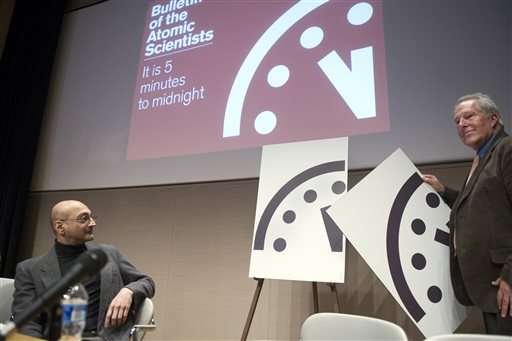Scientists to announce "Doomsday Clock" time

Scientists behind a "Doomsday Clock" that measures the likelihood of a global cataclysm are set to announce Tuesday whether civilization is any closer or farther from disaster.
The Bulletin of the Atomic Scientists is expected to unveil the minute hand on the metaphorical clock in Washington, D.C. The clock reflects how vulnerable the world is to catastrophe from nuclear weapons, climate change and new technologies, according to the bulletin.
California Gov. Jerry Brown will join former U.S. Secretary of State George Shultz and former U.S. Secretary of Defense William Perry for a discussion at Stanford University after the unveiling.
The scientists behind the bulletin adjusted the clock from five minutes-to-midnight to three minutes-to-midnight last year, citing climate change, modernization of nuclear weapons and outsized nuclear weapons arsenals as "extraordinary and undeniable threats to the continued existence of humanity."
The minute hand is assessed each year. It has also previously stayed the same and been adjusted in the opposite direction. Most recently in 2010, bulletin scientists cited nuclear talks between the U.S. and Russia and agreement to limit a rise in global temperature for a change from five minutes-to-midnight to six minutes-to-midnight.
This year's clock is expected to consider tensions between the United States and Russia and the recent North Korean nuclear test.
The Bulletin of the Atomic Scientists was founded in 1945 by University of Chicago scientists who helped develop the first atomic weapons. The clock was created two years later, with midnight symbolizing apocalypse.
The decision to move or leave the clock alone is made by the bulletin's science and security board, which includes physicists and environmental scientists from around the world, in consultation with the bulletin's Board of Sponsors, which includes 17 Nobel laureates.
The closest the clock has come to midnight was two minutes away in 1953, when the Soviet Union tested a hydrogen bomb that followed a U.S. hydrogen bomb test.
Key years in "Doomsday Clock" time
The "Doomsday Clock" by the Bulletin of the Atomic Scientists measures the likelihood of a global cataclysm by reflecting how vulnerable the world is to catastrophe from nuclear weapons, climate change and new technologies. Midnight represents the apocalypse. Here are some key dates in the clock's nearly 70-year history:
1953—The clock comes the closest it ever has to midnight—just two minutes away—after the U.S. and Soviet Union test hydrogen bombs. "The hands of the Clock of Doom have moved again," the Bulletin announces. "Only a few more swings of the pendulum, and, from Moscow to Chicago, atomic explosions will strike midnight for Western civilization."
1981—The clock moves to four minutes-to-midnight after the Soviet Union invades Afghanistan and U.S. President Jimmy Carter pulls the U.S. from the Olympics in Moscow.
1991—The clock drops to 17 minutes-to-midnight as the Cold War officially ends and the U.S. and Russia begin making deep cuts to their nuclear arsenals. "The illusion that tens of thousands of nuclear weapons are a guarantor of national security has been stripped away," the Bulletin says.
1998— The clock moves to nine minutes-to-midnight after India and Pakistan stage nuclear weapons tests.
2015—The clock moves to three minutes-to-midnight. The bulletin cites "unchecked climate change, global nuclear weapons modernizations, and outsized nuclear weapons arsenals" that pose "extraordinary and undeniable threats to the continued existence of humanity."
© 2016 The Associated Press. All rights reserved.


















